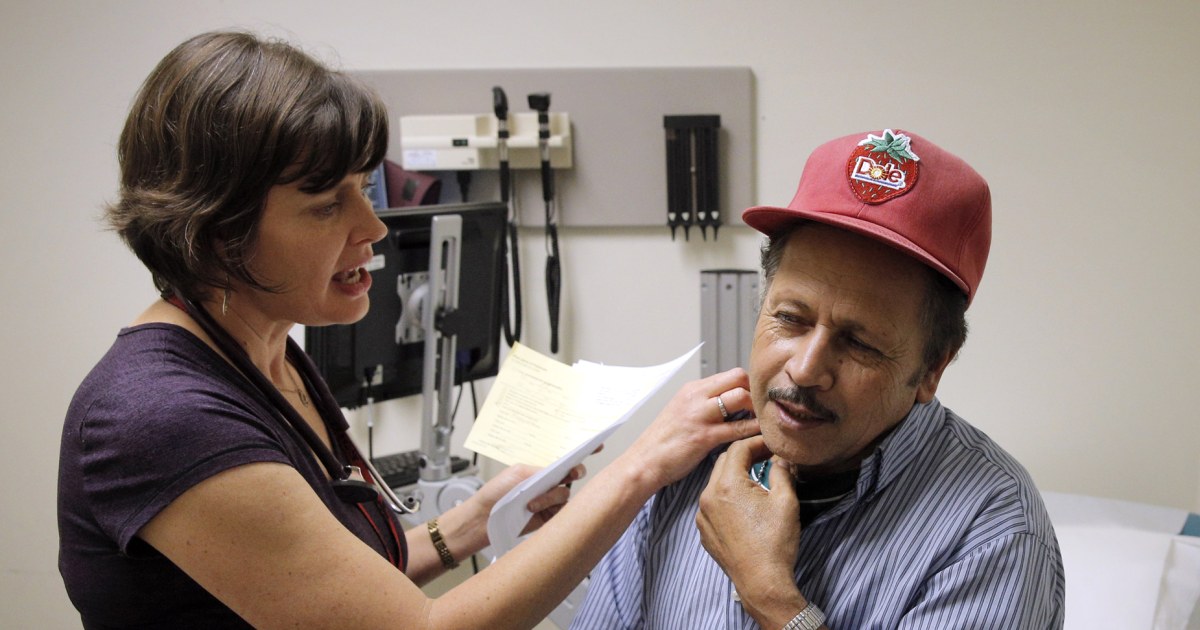
The nation’s health insurance system is undergoing tremendous upheaval as an estimated 8.2 million people will need to find new coverage since pandemic protections for Medicaid enrollees came to an end this spring.
That’s leaving many patients confused about how to get new medical insurance.
“It’s an overwhelming task,” said Taffy Morrison, who is working to connect Louisiana residents to new coverage through the nonprofit Southwest Louisiana Area Health Education Center. But Morrison reminds people: “Don’t panic. There is help.”
For many of those kicked off Medicaid, a state-federal health insurance program that covers people with low incomes and disabilities, new insurance will come from their employers. Others may need to turn to the Affordable Care Act online marketplaces to replace their coverage.
Elevance insurance officials told investors in mid-July they were seeing signs of movement from Medicaid to exchange plans as states ramp up reviews of who still qualifies for the public insurance program. The company, formerly called Anthem, reported 18.2% growth in its exchange plans from the year before, with its marketplace plans now covering at least 949,000 people.
To prevent gaps in insurance coverage, some states, such as California and Rhode Island, will automatically enroll people who lose Medicaid in such marketplace plans. But elsewhere, Morrison and workers at similar nonprofit health groups nationwide are helping people navigate the difficult administrative process of finding the right plan. Known as “navigators” or “assisters” and publicly funded, they work with patients free of charge.
Consumers should be wary of anyone charging to assist them in finding coverage — or pushing a particular plan. Misleading marketing has led some people to plans that aren’t actually insurance, such as health care sharing ministries, which don’t necessarily cover members’ medical bills.
The dramatic reshuffling of insurance coverage comes with the end of federal Covid pandemic protections. States were barred from kicking enrollees off Medicaid during the pandemic to ensure people had access to health care. As a result, the program swelled by 30% from February 2020 to December 2022 to cover about 92 million people, including children who receive coverage under CHIP, the Children’s Health Insurance Program. Now, for the first time since 2020, states have resumed checking whether enrollees remain eligible.
The first batch of numbers are rolling in. So far, more than 3.7 million people have lost coverage in 39 states and the District of Columbia. And in June alone, more than 50,000 of them lived in Louisiana, according to state data. Of the more than 151,000 beneficiaries’ files the state reviewed in a single month, nearly 13,000 people no longer qualified for Medicaid but roughly 38,000 additional people lost coverage because they did not submit a renewal packet for the state to determine whether they still qualified.
Morrison’s group of 50 navigators across the state will now try to make a dent in those numbers as coverage losses are expected to grow.
Patient advocates in Louisiana and elsewhere agree on one crucial first step Medicaid enrollees must take regardless of eligibility status: They must fill out and return their Medicaid renewal packets.
“That Medicaid paperwork, it’s beneficial for everybody to finish it up,” said Geoffrey Oliver, who leads Connecting Kids to Coverage, a program of Legal Services of Eastern Missouri that helps families navigate the enrollment process.
If people return the forms and are found to be ineligible, states pass along their information to online insurance exchanges such as healthcare.gov. The exchanges will follow up with people and share health plan options, functioning as another tap on the shoulder to prevent people from becoming uninsured.
People shouldn’t assume they can’t afford marketplace plans, insurance experts say. Many can enroll in low- to no-cost coverage. Roughly 2.7 million people are likely to be eligible for discounted plans, federal estimates show, representing about one-third of all those expected to be ineligible for Medicaid. Of those, about 1.7 million will qualify for zero-premium plans.
Another reason to fill out the packet: Even if adults in a household no longer qualify for Medicaid coverage, or now have employer coverage, children may still be eligible for public plans.
A message plastered on a billboard in Randolph County, Missouri, reminds people about Medicaid renewal in big, bold letters: “Don’t miss this letter.” About 34% of people living in the central Missouri county are covered by Medicaid, according to a tracker maintained by Washington University in St. Louis.
If people throughout the country fail to turn in the renewal packet, they run the risk of falling through the cracks, said Adrianna McIntyre, an assistant professor of health policy at Harvard. Being uninsured can lead people to postpone preventive care — and cause them to end up in debilitating medical debt if emergencies happen.
Most of the millions cut from Medicaid so far lost their benefits because they didn’t complete the paperwork, not that they were deemed ineligible, according to KFF. And patient advocates worry enrollees may never have received the packet. Many recipients have likely moved and changed addresses but have not updated their contact information with states. Advocates fear those issues may be felt harder in places such as Louisiana, where many people have been displaced by floods and hurricanes in the past three years.
In some states, Medicaid recipients can check their eligibility status online. Elsewhere, they can ask free navigators, such as Morrison, for help checking on their packets.
What to know about navigating the path to insurance coverage
The most important step: Fill out, sign, and return your Medicaid renewal packet.
If you no longer qualify for Medicaid, that denial triggers a special enrollment period for you to find another source of coverage. You typically have 60 days before the loss of your Medicaid coverage to enroll in a new plan; the packets should arrive ahead of losing any coverage, so that should serve as a warning that a change in your benefits may be coming.
You also have 60 days from when you report the loss of coverage, not the date when you actually lost it, to enroll in a new plan. That clock starts when you submit a new application via healthcare.gov, according to federal guidelines.
To avoid gaps in coverage, plan ahead. Most marketplace coverage begins the first day of the following month.
Here are potential coverage options for you and your family:
- Enroll in insurance through your job. Losing Medicaid triggers a special sign-up window for you to enroll in your employer’s insurance, if available.
- Enroll in an Affordable Care Act plan. If employer-based coverage is not available or affordable, you and your family may be eligible for a discounted plan on the exchange. If your portion of the monthly premium for the lowest-cost family plan exceeds 9.12% of your household income, your family members would qualify for an exchange plan that offers financial assistance.
Workplace insurance may be affordable for a father, for example, but not for the rest of the family. “In that situation, Dad should enroll in the employer-sponsored insurance plan and then they should go to the marketplace for the rest of the family,” said Geoffrey Oliver, a navigator who leads Connecting Kids to Coverage, a program of Legal Services of Eastern Missouri.
Your kids may still be eligible for Medicaid even if you no longer qualify:
Even if parents or guardians no longer qualify for Medicaid coverage, their children might. In some places, kids can qualify for the Children’s Health Insurance Program, known as CHIP, with an annual household income of up to 400% of the federal poverty level, which equates to an income of $120,000 for a family of four.
What to do before you turn 19 and lose CHIP coverage:
Some young adults will age out of CHIP coverage at age 19. For them, especially those with chronic health conditions, it’s important to take advantage of the special enrollment period for an Affordable Care Act plan before losing public coverage.
If you turn 19 in the middle of the month — say, September — you should choose an exchange plan in August because most marketplace coverage begins the first day of the following month. This ensures you will not experience a gap in coverage when CHIP coverage expires.
KFF Health News, formerly known as Kaiser Health News (KHN), is a national newsroom that produces in-depth journalism about health issues and is one of the core operating programs at KFF — the independent source for health policy research, polling, and journalism.
Follow NBC HEALTH on Twitter & Facebook.






